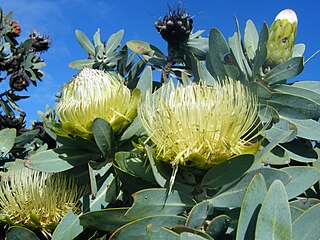
Vitellaria paradoxa, commonly known as shea tree, shi tree, or vitellaria, is a tree of the family Sapotaceae. It is the only species in the genus Vitellaria, and is indigenous to Africa.

Mount Cameroon is an active volcano in the South West region of Cameroon next to the city of Buea near the Gulf of Guinea. Mount Cameroon is also known as Cameroon Mountain or Fako or by its indigenous name Mongo ma Ndemi. It is the highest point in sub-Saharan western and central Africa, the fourth-most prominent peak in Africa, and the 31st-most prominent in the world. The mountain is part of the area of volcanic activity known as the Cameroon Volcanic Line, which also includes Lake Nyos, the site of a disaster in 1986. The most recent eruption occurred on February 3, 2012.

Conocarpus erectus, commonly called buttonwood or button mangrove, is a mangrove shrub in the family Combretaceae. This species grows on shorelines in tropical and subtropical regions around the world.

Juniperus occidentalis, known as the western juniper, is a shrub or tree native to the Western United States, growing in mountains at altitudes of 800–3,000 meters (2,600–9,800 ft) and rarely down to 100 m (330 ft). It is listed as Least Concern on the IUCN Red List because it is a widespread species with an increasing population.
Gilbertiodendron splendidum is a tall forest tree of lowland swamp forests of coastal West Africa in the family Fabaceae. It is found in Upper Guinean forests along coastal regions of Côte d'Ivoire, Ghana, and Sierra Leone. It is threatened by habitat loss.
Guibourtia ehie is an evergreen tree of the genus Guibourtia in the family Fabaceae, also known by the common names amazique, amazoué, hyedua, black hyedua, mozambique, ovangkol and shedua.

Pericopsis elata is a species of flowering plant in the family Fabaceae and is known by the common names African teak, afromosia, afrormosia, kokrodua and assamela.
Milicia regia is a species of tropical tree in the family Moraceae. It grows in a belt on the west coast of Africa that extends from the Gambia to Ghana. It is threatened by habitat loss and logging.
Pierreodendron kerstingii is a species of tree in the family Simaroubaceae. It is endemic to West Africa and found in Ivory Coast, Ghana, Togo, and Benin. It is sometimes considered synonym of Pierreodendron africanum, which would then be a widespread species distributed south to Angola and east to the Democratic Republic of the Congo.

Pterocarpus santalinoides is a tree species in the legume family (biology) (Fabaceae); it is locally known as mututi.
Tieghemella africana is a tree species of the genus Tieghemella in the plant family Sapotaceae. It occurs in Cameroon, the Republic of the Congo, Gabon, and Sierra Leone and is threatened by habitat loss and overharvesting.

Tieghemella is a genus of the plant family Sapotaceae described as a genus in 1890. The wood of Tieghemella species is known as makore in the lumber trade.

Turraeanthus africanus is a species of plant in the family Meliaceae, also known by the common names avodiré, apeya, engan, agbe, lusamba, wansenwa, African satinwood, and African white mahogany.
Assagny National Park or Azagny National Park is a national park in the south of Ivory Coast. It is situated on the coast some 75 km (47 mi) to the west of Abidjan, between the mouth of the Bandama River and the Ébrié Lagoon, and occupies an area of about 17,000 hectares.

Protea nitida, commonly called wagon tree, waboom or blousuikerbos, is a large, slow-growing Protea endemic to South Africa. It is one of the few Protea species that grows into trees, and the only one that has usable timber.
Cordia platythyrsa or West African cordia is a tall, flowering tree in the borage family (Boraginaceae), native to western and central Africa. Its soft wood is often used for furniture or other carpentry. It is considered "vulnerable" as it is threatened by logging.

Diplorhynchus is a monotypic genus of plant in the family Apocynaceae native to tropical and southern Africa. As of August 2020, Plants of the World Online recognises the single species Diplorhynchus condylocarpon.

Strombosia pustulata is a species of tree in the family Olacaceae. It is native to the rainforests of tropical West and Central Africa. Common names for this tree include itako in Nigeria, afina in Ghana, poé in Abé spoken in Côte d'Ivoire and mba esogo in Equatorial Guinea.
According to Ghana’s Forestry officials, the big tree near the town of Akim Oda which is 66.5 m (218 ft) tall and 396 cm (13 ft) in diameter is believed to be the biggest tree ever discovered in Ghana and West Africa. It is a member of the species Tieghemella heckelii. It is located in the Esen Apam Forest Reserve, about 22 kilometers from Akim Oda, about 300 m (1,000 ft) off the Oda-Agona Swedru trunk road.

Polyscias fulva is a species of flowering plant. It is an evergreen or deciduous tree, native to the mountains of tropical Africa and the southwestern Arabian Peninsula.













